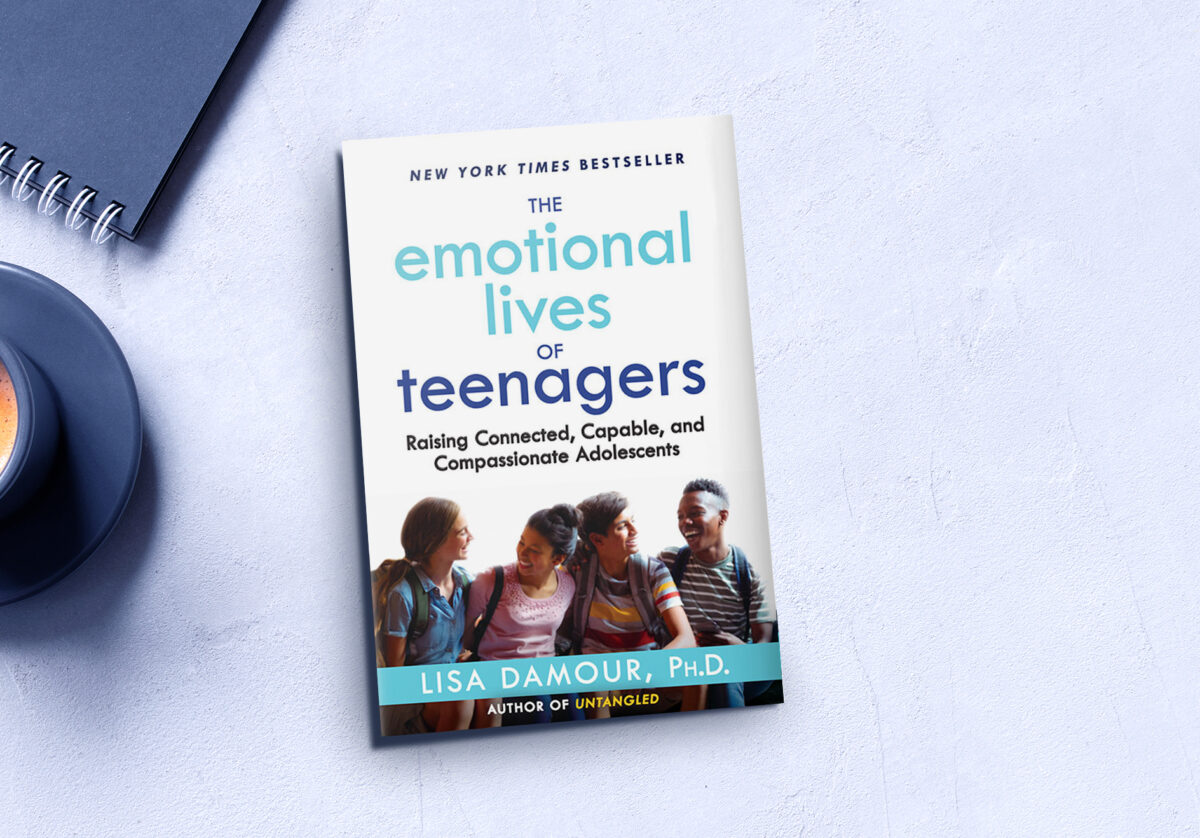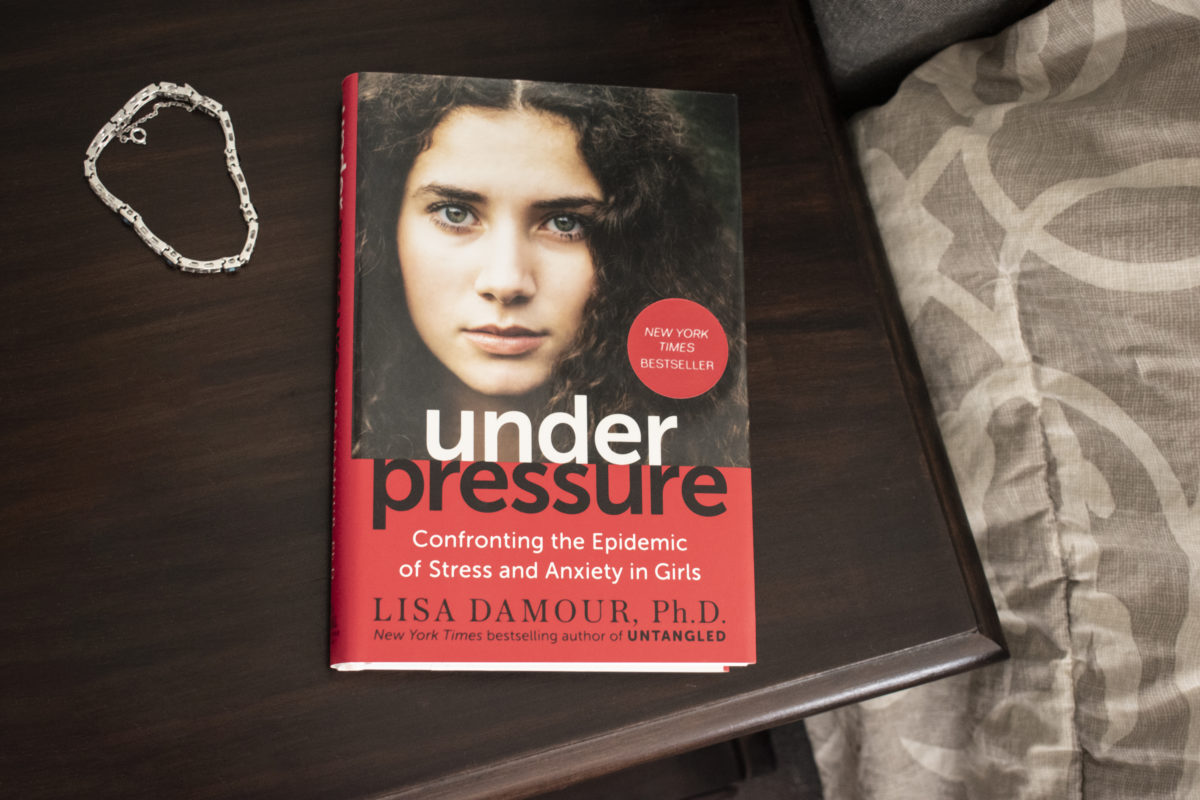In this episode Lisa and Reena discuss Lisa’s new book and the research behind it. Lisa explains why she felt passionate about writing the book, the strategies it offers parents for navigating the teen years, and how it will help parents know what’s typical teen behavior and when it’s time to worry. Reena asks if the pandemic forever changed teen behavior and how gender influences the experience of emotion. Lisa describes what the research says about what men need to do to help boys handle emotions well and the big take-aways she hopes parents will get from her book.
February 21, 2023 | 33 min
Transcript | Lisa’s New Book! The Emotional Lives of Teenagers
Ask Lisa Podcast, Ep. 107: Lisa’s New Book! The Emotional Lives of Teenagers
The Ask Lisa Podcast does not constitute medical advice and is not a substitute for professional mental health advice, diagnosis or treatment. If you have concerns about your child’s well-being, consult a physician or mental health professional.
The following transcript has been automatically generated by an AI system and should be used for informational purposes only. We cannot guarantee the accuracy, completeness, or timeliness of the information provided.
——
Reena Ninan
Okay, I can’t tell you, this is the episode of the season that I have been waiting to do. It’s your new book. This is my advanced copy that I was lucky enough to get early on. But I am so excited for you and for the world, my friend, you have so hard on this. And it’s here. How do you feel? Is it like giving birth?
Lisa Damour
It kind of is, actually. I mean, it’s out today. And it’s very funny. It’s my third book for broad audiences. And you do feel about your book. So when you feel about your kids, like you don’t have a favorite, you love them all. They’re all special in their way. It’s wonderful to have one come into the world. So yeah, it’s actually a lot like having a baby.
Reena Ninan
It’s so funny. So I, you have been working so hard last year, you were feverishly putting it together doing the research and what I love. My favorite thing about all your books is it’s not like this is what I kind of think you are grounded in science, and research and real, everyday clinical episodes of things that have happened that you’ve seen over two decades, more than two decades.
Lisa Damour
It’s true. Like I can’t believe I get to sit in this space where I sort of feel like I have a three legged stool that I get to work from, you know, one is the research science of the field. One is my work with parents and one is my work with teenagers. And getting to work across those and integrate them into a book is one of my favorite things to do. And one thing that people will notice if they get the book is that it looks thicker. That sounds strange to say than it is because the book itself, the text of the book clocks in at under 200 pages. It’s not an overwhelming book. But it then goes on for 50 more pages of notes, which is great, I highly I love it. And I also love the way in which if people want to know more about the studies that I’m citing or want to see what actually amounts to a pretty detailed interaction that I often have with clinical and research colleagues in the notes about why I’ve made this argument in this particular way. If people are interested in that it is all there. And if they’re not interested in that they can just leave it aside. But I really love the way that we can use notes and a book like mine to have bulls be what I hope is a very readable, accessible text. And then if people are very curious or want to know more about what I’m grounding it in that that’s all in the book, too.
Reena Ninan
What I love is you use your years of work in your office talking to teens, and you weave them and you’ve obviously protected the identity to no one would ever be able to tell a change names. But hearing that, and then the way you weave in the research and what you’re seeing and the trends, which was also interesting, because you put it into context.
Lisa Damour
Yes, this is an interesting, it was an interesting time to write a book about the emotional lives of teenagers, because there’s no question that a big inspiration for the book was the pandemic and was what our teenagers went through and how hard it was on teenagers. But then, you know, I don’t want to write a pandemic book, you know, I hope that this really feels like it’s in the rearview mirror and more and more so all the time. But what I hope the book does is really grounds us back in what we know about mental health and adolescents, how we maintain it for them, how we support them in maintaining it, when to worry, you know, I think so much of my work is around trying to reassure parents that what you’re seeing with your teenager, even if it’s intense, and sometimes a lot of friction and very uncomfortable. I really so much of that is normal to adolescents. And so what I have found that is that a very a way that I can convincingly reassure parents that what they’re looking at is typical is to be very clear about where the line is and when it is time to be concerned because I think that’s really how I always want to know like if I’m if I have a medical concern, I would want one someone to say you don’t have to worry until x and then x doesn’t arrive. I’m good Go. So I try to provide that to my readers as much as I can.
Reena Ninan
The Emotional Lives of Teenagers, I love that title because it tells you exactly what this book is about why this topic and why now.
Lisa Damour
So it was actually two things. So one was the pandemic, the rise of distress and teenagers everywhere. But I would say, as much if not more powerful than the pandemic, was a growing misunderstanding about what mental health really is in anyone, much less teenagers. And what I mean by that Reena is, I have watched bluntly, the wellness industry shape how we talk about mental health. And what I mean by that is, we have arrived as a culture at a very bad definition of mental health, which is that you know, you’re mentally healthy if you feel good or calm or relaxed. And I just can tell you, like, no one in my field would be in agreement with that definition. And it’s actually a really problematic definition. Because what it means is if you start the day feeling good, and then something awful happens or unpleasant happens, and you feel lousy. Now you’re worried about your mental health, as opposed to the fact that you’re just having a very bad day. So the main, the two main forces that got me to sit down, and basically not get up from on top, to write this book, one was the pandemic. And the other was that I wanted to make sure we got a very clear understanding of what mental health is. And that is that teenagers, and actually people of any age, have feelings that fit the moment they’re in, they make sense in their context, and that they are managing those feelings effectively. So they can actually be quite distressed. And that may be totally natural to adolescents, what we’re looking at is, if they’re handling those feelings in ways that bring relief, and do no harm, or in ways that bring relief, but actually come at a cost.
Reena Ninan
I think that’s also one of the takeaways from this book was about how teaching our kids that being in distress and sometimes can be an appropriate feeling and our emotion, and we’re constantly trying to tell them no, no, you know what, you don’t wanna feel that way. You don’t feel that way. But you can lean into it. And you can also get up from it.
Lisa Damour
Absolutely. That you know, I mean, if your kid messes up a test that they didn’t study for, and they feel mad at themselves and unhappy with the grade. Yeah, those are both extremely unpleasant feelings. Those are gonna help your kid grow, those are gonna help your kid do you know that if they don’t want to feel that way? Again, they’re going to change their behavior. And so I think as parents, you know, we so often I feel like we’re linebackers trying to keep negative feelings away from our quarterback kid, you know, I think I think what we really want to appreciate is sometimes getting knocked down, really clarifies for kids, how they want to be in the world, what they want to do differently, they have to have moments that are quite uncomfortable, to grow and to learn. And our job as adults is to have strategies to support them through it, not try to prevent them that from happening.
Reena Ninan
And what I love, it’s a quick reminder for adults that you’re not always supposed to feel up to, you know, that we feel the burden of caretaking and always having to be happy enough. But But hearing you say that was really remarkable. Lisa, I want to turn sort of to COVID as we’re merging out of COVID. I’m just curious, what do you think has changed? Or Has anything changed in teen behavior and development as we move on past COVID? And is there anything you can definitively say? Yeah, that’s forever changed in child development?
Lisa Damour
Oh, man, what an important question. Okay. So let me take this in a couple of ways. First of all, I would say, a great percentage of teenagers are back to business right back on the natural trajectories of adolescence functioning, just the way I mean, this is the real value of having practice, so long before the pandemic is I have a very solid baseline for what I should be seeing in teenagers. So I would say a lot of teenagers are operating exactly as we would expect they would and marching forward in all good health. Okay, but for them, here’s what’s really interesting. normal adolescent development is a bumpy road. Yes. And it always has been. And so what I am seeing, even for kids, where I have zero concerns, or who seem very much on the normal trajectory, what I’m seeing is that their parents are unduly anxious, because the pandemic number one rocked our world. And number two, has given rise to daily headlines about adolescent mental health concerns. And my huge beef Reena, is it so many of these headlines make no distinction between typical adolescent distress and an adolescent mental health concern? So one thing I will say, and this is a big part of why I wrote this book, is a post pandemic on caring for a lot of parents who are describing to me typical adolescent development as I’ve ever and always seen it with all of its ups and downs and with all of its emotional disruption, and they are really scared because they aren’t sure if what they’re looking at is normal and expectable or Were a sign of concern. In the wake of the pandemic, I think the pandemic really jostled our sense of what the norms were really changed our, you know, we lost our baselines for what to expect. Okay, so there’s that, then there are also kids who do suffer from ramifications of the pandemic. And I will say, the main form I see of this, I mean, there’s a million versions that are individual to specific people. But the main form is the default use of avoidance to manage distress, that went on doing sometimes not doing something not going to school, the data, Reena, on kids not going to school, post pandemic, we’ve never seen anything like this ever.
Reena Ninan
So this isn’t a one off. I think if your child isn’t experiencing this, and they’re going to school, and they’re happy to be in school, you don’t think this is a big deal. But you are saying you are looking at the research, and you are seeing numbers of children who just can’t rejoin society. Again, it’s what it sounds like.
Lisa Damour
They’re Yeah, they’re just not showing up for school. And there’s, you know, when you look when you break this down socio economically, there are different explanations at different, you know, points at the socio economic spectrum. But it does not actually matter who you’re talking to, you can talk to some of the wealthiest districts and some of the most impoverished districts, and those superintendents will tell you that there are numbers of school avoidance or truancy or absence, you know, chronic absenteeism, it gets called a lot of different things. These have, like doubled and tripled, post pandemic, and they haven’t, they’re not correcting Wow. And so one of the things that I work really hard in this book to help parents with, is to make a distinction between kids being uncomfortable or being in a situation that’s unmanageable. Because sometimes kids are mashing those two together, and they’re saying, if it’s uncomfortable, I can’t do it, I’m staying home, or I’m not going to do that thing. I’m going to use avoidance. And if things are the sons, minimizing it, I don’t mean it in this way, if things are merely uncomfortable, if it’s not unmanageable, but if it’s merely uncomfortable. This book comes with two entire chapters of strategies to help kids manage uncomfortable situations so that they can move forward into and through them.
Reena Ninan
You just took my teas going into the break. Lisa, the one thing there’s one thing that you are, there’s one reason that you should purchase this book, it’s the strategies, I learned so much about the things that we can say and pivot to, that keeps you kind of on neutral footing, but keeps them rethinking without feeding into the emotional moment. I thought those were so good because there’s such takeaways in each chapter of how you can respond and I learned so much, you know, as a parent, I’m actually implementing some of these strategies already. I’m not raving about this because you’re my friend and my beloved girlfriend and counselor. And wise sage. I love this because there are tangible things in here. Like I was saying that every parent can use strategies and it’s such an easy read guys. It is such an easy read. And by the way, Lisa taped an audio book in her own voice that’s available now right?
Lisa Damour
Yep, it’s all out too. A they publish both the print and the audio simultaneously. And I love doing the audio book actually. And I feel like there’s a whole other layer of utility I can add, if I can do it in my own voice, by tone, but whatever works for people, if they’re interested in buying this book, I want them to do what works best for them.
Reena Ninan
Well, I’ve got both because I’ve got the book and then also download, you’ve got to download it, because for the car, doing your walks, it’s just helpful, I think, to hear some things being reinforced. But, you know, one of the biggest surprises to me, was how you really talk about the importance of dads of talking about their emotions. It was just so impactful hearing this from you, because you talk about the research. What is it that you found about dads talking about emotions that can be so transformative for children?
Lisa Damour
So this was so you know, I’m just a nerd. Like any chance–
Reena Ninan
You’re grounded in research and studies, you don’t just say, Oh, this is what I think today, you know, because of one experience with my child, you really love research.
Lisa Damour
And I love it. And so the second chapter of this book is called Gender and emotion. And people who followed my work know that prior to this, my book length work has centered on girls. And so this is my first all genders book, though, you know, obviously, our podcast addresses all genders in my work, and the New York Times has for a long time, as well. But I sat down to that chapter and just really pulled all the research I could find on how gender influences the experience of emotion, the experience and expression of it. And one thing that was not new to me and won’t be new to our listeners is that girls are as a group, socialized to talk about feelings far more than boys are, you know that it’s very much, you know, typical to raising. You know, a girl, though, that we talk with her about feelings, we expect her to talk about feelings, she gets together with her girlfriends, they talk about feelings. And we know that boys just do this last we talk with him about emotions less than than we know, they talk with one another about emotions less, and they become less capable in that way. And so that I knew, but what became clear to me as I was working through the research, is that the solution that people so often seek, and I’ll tell you exactly how this goes down, is that moms are saying to me, how do I get my son to talk about his feelings, he doesn’t talk about his feelings. The solution we so often seek, which is bluntly that the mom who in most homes that are heterosexual homes or two parent homes that are heterosexual, they’re the ones who are doing the emotional work at home. They’re the ones asking about feelings, because again, in that gender pattern, women are trained to do this. What I what became very clear to me from the research is that if the mother is the only one talking about and asking about feelings, it actually entrenches the problem for boys. And here’s what I mean, the problem for boys, in addition to not having the fluency because of just how they’re socialized, is it somewhere around fifth or sixth grade, they start to get very, very oriented towards like, What’s a girl thing to do? And what’s a boy thing to do, right. And of course, I’m talking about very conventional gender dynamics here. And they quickly decide that talking about feelings is a girl thing to do. And so for boys who are really trying to establish their sense of masculinity, it’s off the table. So then when they come home, and their mom is the only one saying, let’s talk about your feelings, it actually proves their point like this is a girl thing to do. I’m not doing it. So if we really want boys to talk about feelings, which we do, it has to be the men in their lives who step up, and who say, tell me how you’re feeling buddy, or let me tell you how I’m feeling today. That has to happen. Anything else may actually exacerbate the very problem it is trying to solve.
Reena Ninan
So you’re saying the men in their lives so if you’re a single parent, I’m a mom, but I feel good that I’m talking to my son about feelings, you say, it’s still really important to find that male figure who might be in his life somewhere to talk about feelings.
Lisa Damour
Individual families, everyone’s going to sort it out in their own way. So you know, I, you know, I know plenty of families with two moms or two dads where their kids are thriving, you know, or single parents where their kids are thriving in their emotional fluency. But in super broad strokes, regardless of the configuration of your homework, maybe especially if you’re talking about a single parent who’s a woman. You want other men around getting boys talking about their feelings, and this can be uncles and coaches and neighbors and bosses and you know, like there’s a huge array of people who are available to do this. And I’m not saying if you’re a woman, don’t ask your son about this really So
Reena Ninan
I can get there’s no impact. You know, there’s a difference you’ve seen in the research.
Lisa Damour
It really matters, that men do this work, it really matters that men do this work.
Reena Ninan
I want to get back to a little bit about when teens experience emotional distress. You talk about that quite a bit in the book, when they do, what really works, what helps What should parents keep in mind.
Lisa Damour
So the book itself gets very deeply into this question of how we help kids, the term we use is regulate emotions, right? So if we can’t keep kids from having distress, which we can’t, and if we can’t get rid of it right away, which we can’t, what we do in its place is to regulate emotions. And there’s a lot of strategies for that. And so I have two entire chapters on the regulation of emotion. And I think that people think that people may be surprised when they come across these chapters is that I have put on equal footing, given a chapter to each regulating emotions by expressing them talking about them as kids and getting them out. And regulating emotions by bringing them back under control. And, and what I mean by that is helping kids are watching supporting kids as they comfort themselves or find a distraction or turn towards problem solving. Maybe not talk about the feeling so much. And I think the reason it may come as a surprise is that we very much at this point in our culture default to the idea that if my kid is upset, the number one and perhaps sole solution is I get them to talk to me about what they’re feeling. And we talk about it, talk about it, talk about it till it’s gone. And I will tell you Reena, when I was enormously pregnant with my older daughter, the one who’s now in college, so this is now like 20 years ago. And I was quite a young clinician at that point, I was about to go deliver her like it was like a week before her delivery. And I was wrapping up a meeting with a senior colleague. And and I think, you know, we knew we wouldn’t see each other until after I’d had my baby. And, and she said to me after the meeting ended, she said, so I’m 20 her house psychologist mess up their kids. Because I’ve seen those kids this need to be good. Yeah. And she said they talk about feelings too much. Oh, yeah, that when the kid is having a meltdown, they are just excavating, excavating, asking and asking. And she said, there comes a point where it’s really helpful to say, okay, you’ve been upset for a while, let’s figure out what’s gonna help you feel better, right? The raining it back in. And Reena, what I will tell you is I feel like in the intervening 20 years, the whole culture has moved into the bad psychologist parent mode, right of like, everything gets discussed and talk to death. So there is a place for getting kids talking about feelings. And I have an entire chapter on helping kids express emotions either verbally or non verbally. But there is also an entire chapter on strategies to help kids get their feelings back under control.
Reena Ninan
That is so fascinating about the psychologist, like, you know, talking too much about your emotions cannot can be unproductive.
Lisa Damour
It can and the term we have a term for it, we call it rumination, right, which is the technical term in psychology for where you are, you know, picking it an emotional wound basically like the more you talk about it, the worse you feel, as opposed to taking another tack. And so I’m very explicit in the book about when talking is a great strategy. And also when to know if it stopped working. And it’s time to actually switch gears.
Reena Ninan
I love it. I just think there are so many I’m going through this book right now just to look at the table of contents to tell you guys the different things, the myths of getting past adolescent emotions, like just a basic one on one on this. managing emotions and regaining emotional control, I just the seismic shift how adolescents puts a new emotional spin on everyday life. It’s just such a, to me a Bible is what I feel like it is because it explains and decodes what kids are going through. I mean, you even talk about what actually happens in the brain, as some of these emotions are going on, which no one has ever explained that to me. I mean, when you’re handed a child, someone should say you’re not gonna understand this. But when they get to their teen years, here’s what’s happening inside their head.
Lisa Damour
It’s quite remarkable, Reena. I mean, it’s a massive renovation, and it kicks off with puberty. And puberty kicks off, you know, by 10, or 11. Even if you can’t see the outward signs, things are shifting and changing inside. And it overhauls who your kid is, and I think we know this and we don’t right? Like we can easily say ya know, 10 year olds have very little in common with 17 year olds. But at the same time when we’re bearing witness to this pretty dramatic transformation. It’s very unsettling. And so I really do try to map out how the brain changes and what this means I’ll say it bluntly in your kitchen.
It means your kid is having a lot of meltdowns, it means that you’re not always able to have productive conversations when they’re upset. It means that they can be impulsive in ways that won’t be true at other points in life. And so, you know, me, like I try to both offer an explanation and offer a series of strategies. And that’s the other thing we know, like, I really, the longer I practice, the more humble I am about what’s going to work in any one home, right? You know, your kid, you know, yourself, you know, the context. And so I find myself more and more when people ask me questions, or when I’m writing, they say, How do I do this, I’ll say, Well, let me give you three or four options, because you’re gonna need on either with the same kid in different contexts, or I may say something that is totally not gonna work for you or your kid. And that’s fine. I just feel like my goal in all of my work, and then especially in this book, is to hand people a giant toolkit and just say, here’s a bunch of tools, and see if see which one’s gonna work for you on a given day.
Reena Ninan
That’s it. It’s a toolkit that you literally hand over and with this book, on how to really raise these children, and you meeting us in the moment, as we’re talking about emerging out of this pandemic, and what we’ve lost being honest about that and where child development is going. So I’m so grateful, what is it least that you hope parents will take away from this book,
Lisa Damour
I feel pretty clear about what it what I really want the walk away to be for families. And I would say, number one is a few things. Number one, it’s okay for your kid to be in distress. There are times when we worry, but those are comparatively rare. In the day in day out, you should expect a fair bit of distress in your teenager, like I think that’s something that we just need to reestablish post pandemic, I think Second, I want parents to know you can’t prevent that, right. And actually don’t even always want to, often you don’t want to. And then finally, what you can do is support regulation. And that’s what this book at the end of the day is really about is helping kids regulate emotions in really healthy ways. So that they can be calm, connected, capable and compassionate people.
Reena Ninan
I love it. And I don’t know how people are gonna choose to read this, but I literally have written so many margins, to go back and make sort of a little cheat sheet for myself on just some of the strategies and and just reminding myself of the research that, you know, I’m not just doing this willy nilly. And sometimes you’re you do things because your parents did it one way, or you’re conditioned to believe it to be because of your social settings. But I just, I shouldn’t be amazed because I know how much research and effort you put into, you know, writing this during this time period. But I’m blown away by all of the stats and how thoroughly This is researched. I you know, I’m a journalist, so I like backs and things down the middle. And it’s really a brilliant book, congratulations, my friend, proud of you.
Lisa Damour
It means you have no idea what it means to me. And I just, you know, I can’t believe I get up every day. I’m like, I can’t believe this is my job. I can’t believe we get to help people the way we get to try at least Yeah, it’s like what a what a gift for us to get to do this.
Reena Ninan
Democratizing mental health access. That’s always been a goal of this podcast. Well, Lisa, what do you have for us for parenting to go?
Lisa Damour
What I would say for parenting to go is that I don’t know that I’ve ever seen a harder time to be a racer teenager, I just I’ve practiced, you know, I’m pushing 30 years. Reena, like I’ve really seen a lot. And I think this is a very harrowing time with headlines that are scary, and worries about the future. And so what I would say for parenting to go is you’re not in the salon. There’s so much we can do. And I would say the number one reason of all the reasons we’ve talked about for why I wrote this book, is that when I think about adolescent mental health and how we support it, occasionally, it’s going to be clinical professionals who need to be called in. Overwhelmingly, the way that we support adolescent mental health is by building very strong relationships between teenagers and the adults right around them. And really, ideally, that’s going to be their parents. And if not, there’s other adults who can step in. But this is a book that’s really designed to build those strong relationships because that’s how we support adolescent mental health.
Reena Ninan
Well you detail how to lay that brick by brick, so I’m so grateful for this and it’s such a great read and an easy read and accessible. So thank you for that. Congratulations, Lisa. The emotional lives of teenagers raising connected, capable and compassionate adolescence by Dr. Lisa Damour out today please go get it you’re gonna love it and send it to a friend too. I think this is this is actually a great housewarming gift. birthday gift. It really changed my life and I used to you know, I used to have stacks of your of untangle that I would literally hand out to people I had it in my office and I just it when you find a book that really speaks to your soul and helps you you want to tell everyone so congratulations, my friend.
Lisa Damour
Thank you, Reena.
Reena Ninan
So next week we’re going to talk about how do you help your disorganized team get it together. I’ll see you next week.
Lisa Damour
I’ll see you next week.
More resources

















